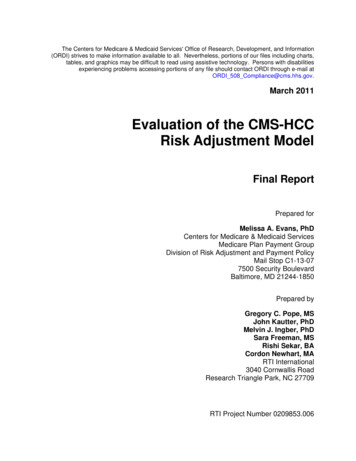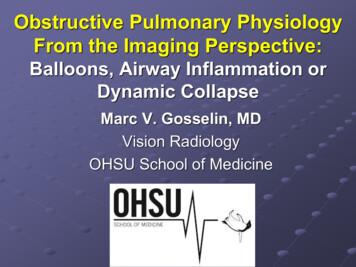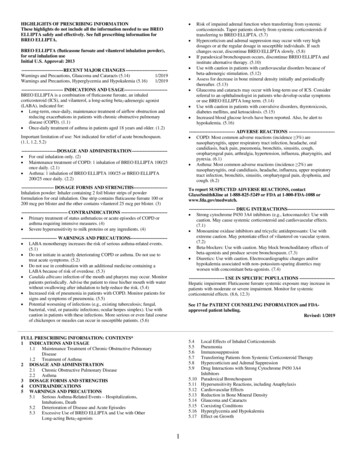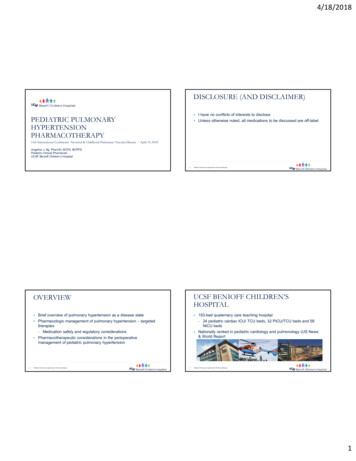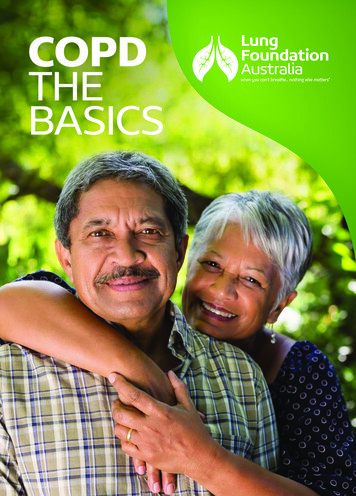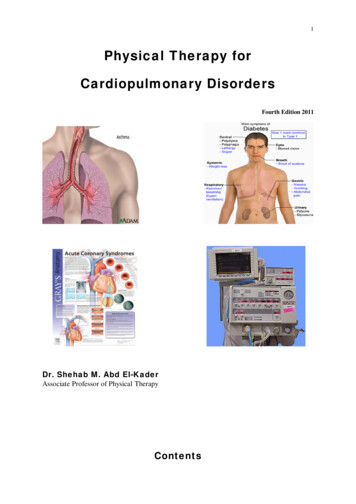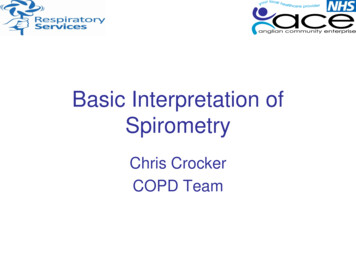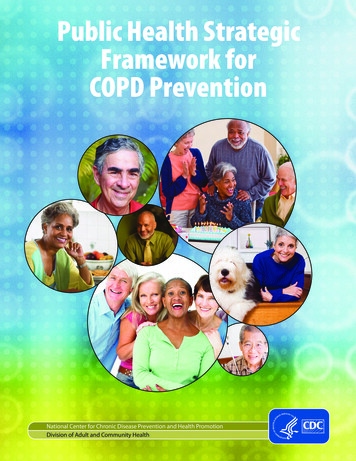
Transcription
Public Health StrategicFramework forCOPD PreventionNational Center for Chronic Disease Prevention and Health PromotionDivision of Adult and Community Health
Suggested Citation: Centers for Disease Control and Prevention. Public Health Strategic Frameworkfor COPD Prevention. Atlanta, GA: Centers for Disease Control and Prevention; 2011.Available at www.cdc.gov/copdDisclaimer: The findings and conclusions in this report are those of the authors and do not necessarilyrepresent the official position of the Centers for Disease Control and Prevention.
IntroductionIn the spring of 2010, the Centers for Disease Control and Prevention (CDC) and severalpartners embarked on an intensive process to examine the current state of knowledgeregarding chronic obstructive pulmonary disease (COPD) prevention. The process includedidentifying public health gaps and generating a set of goals that would define the unique roleand contributions of public health in the prevention and control of COPD. This workgrouprepresented other federal agencies, academia, the health care sector, national organizations, andother COPD stakeholders. The purpose of this report is to provide a framework that could beused by the public health community to address COPD as an important public health issue.BackgroundApproximately, 12 million Americans have been diagnosed with COPD, but at least another12 million Americans may be undiagnosed (1). COPD refers to a group of chronic diseases,including emphysema and chronic bronchitis, that impair the flow of air in the lungs and makebreathing difficult. While COPD death rates are higher among men than women, over thepast 20 years, the number of COPD deaths among U.S. women has increased much faster thanthose among men (1–3). COPD death rates are also higher among whites than among AfricanAmericans or persons of other races (1–3), and in some states, including Idaho and Indiana(3). In addition, women had more COPD hospitalizations than men and more emergencydepartment visits (1,2,4).PreventionApproximately 75% of COPD cases are attributed to cigarette smoking (5). Occupation-relatedexposures may account for another 15% of COPD cases (6) and genetic factors, asthma,respiratory infections, and indoor and outdoor exposures to air pollutants also play a role(6,7). Thus, COPD largely can be prevented. Prevention of COPD begins with reducing and/or eliminating smoking initiation among teenagers and young adults and encouraging tobaccocessation among current smokers. More than 20 million workers in the United States have beenexposed to gases, vapors, fumes, and dusts that may cause COPD (6). Public health programsand policies that focus on tobacco-use prevention and cessation, reducing occupationalexposure to dusts and chemicals, and reducing other indoor and outdoor air pollutants arecritically important. Early treatment and control of asthma may also prevent the developmentof COPD.1
DiagnosisCommon symptoms of COPD include shortness of breath, cough, phlegm, and wheezing. Asmany as one-half of all persons with symptoms of COPD have not been diagnosed becausethese signs are often attributed to aging or “normal” smoker’s symptoms. A definitive diagnosisof COPD involves measuring lung function using spirometry, which is a noninvasive outpatientprocedure.TreatmentOnce COPD has been diagnosed, goals of treatment and management include relievingsymptoms; preventing and treating disease progression, complications, and exacerbations;improving exercise tolerance, daily activity, and health status; monitoring nutritional needs;and reducing premature mortality (8). Management should include smoking cessation andabstinence; limiting exposure to secondhand smoke, dusts, fumes, and gases; pharmacologicaltreatment with bronchodilators and corticosteroids; supplemental oxygen therapy; pulmonaryrehabilitation; collaborative self-management; and surgery (8). Clearly, efforts toward patientand professional education should continue to focus on promoting treatment modalities forpersons with COPD as well as persons at risk for COPD.Public Health GoalsThe workgroup identified four goals that were grounded in the following public health areas:(1) surveillance and evaluation: improve collection, analysis, dissemination, and reporting ofCOPD-related public health data; (2) public health research and prevention strategies: improveunderstanding of COPD development, prevention, and treatment; (3) programs and policies:increase effective collaboration among stakeholders with COPD-related interests; and (4)communication: heighten awareness of COPD among a broad spectrum of stakeholders anddecision makers (Table 1). To accomplish these goals, the workgroup proposed the followingobjectives, strategies, and actions based on a detailed, scientific rationale.2
Goal 1: Surveillance and EvaluationImprove collection, analysis, dissemination, and reporting of COPD-related public health data.Objectives Adapt and expand current national population-based surveillance systems such as theBehavioral Risk Factor Surveillance System (BRFSS, state-based, self-reported data),National Health and Nutrition Examination Survey (NHANES, national data collectioninvolving a combination of interviews, spirometry, and physical examinations), and theNational Health Interview Survey (NHIS, national, self-reported data) to include moreCOPD-related information. Adapt and expand current national health care surveillance systems (health care systembased surveys) to include COPD-related information. Analyze and report COPD-relevant data from these surveys.RationaleOngoing data collection is required to assess the nation’s progress toward Healthy People2020 COPD objectives which includes: (1) Reduce activity limitations among adults withchronic obstructive pulmonary disease (COPD); (2) Reduce deaths from chronic obstructivepulmonary disease (COPD) among adults; (3) Reduce hospitalizations for chronic obstructivepulmonary disease (COPD); and (4) (Developmental) Increase the proportion of adults withabnormal lung function whose underlying obstructive disease has been diagnosed. Currentpopulation-based surveys already capture some information related to COPD such as smokingprevalence, medical care utilization, and prevalence of chronic health conditions. However,COPD-related topics could be analyzed more extensively in current surveillance systems andnew questions could be added to existing surveys. Due to the designs and periodic revisionsof these surveys, adapting or adding new questions related to COPD to existing surveys wouldbe more time- and cost-efficient than creating new surveillance systems specifically focused onCOPD.3
Strategy 1: Maximize use of currently available data.Potential actions include: Analyzing currently available data relevant to COPD in existing surveys (BRFSS,NHANES, NHIS, etc.); Publishing high profile CDC reports on COPD-related topics; Developing a comprehensive report of information (e.g., surveillance summary) acrosssurveys regarding COPD every 4 years; Presenting information on current COPD-related NHANES survey data addressingoccupational risk factors.Strategy 2: Develop and initiate new data collection within existing surveys.Potential actions include: Adding new questions related to COPD to existing surveys; Developing and testing new questions for reliability and validity, as needed; Refining the definition of COPD in existing surveillance systems by adding theterms “COPD” and “chronic obstructive pulmonary disease” to the currently used“emphysema” and “chronic bronchitis” terms; Adding new questions on occupational and environmental exposures; Including new queries on genetics and family history; Inserting new questions related to asthma; Promoting collaborations between federal agencies to develop and implementstandardized COPD-related questions.4
Strategy 3: Improve the ability of federal agencies to collect, analyze, and reporthealth care data from electronic health records (EHR).Potential actions include: Supporting the development of uniform EHR definitions of COPD; Supporting collection of clinical measures and risk factors for COPD includingoccupation, family history, genetics, and smoking as part of EHRs; Developing templates for collection of clinical data; Developing standard COPD-related measurements (i.e., as determined by the NationalCommittee for Quality Assurance’s Healthcare Effectiveness Data and Information Setand the National Quality Forum) in EHRs for the Centers for Medicare & MedicaidServices, Health Resources and Services Administration, Department of VeteransAffairs, and the U.S. Department of Defense; Developing partnerships with health care delivery systems for pilot projects usingEHRs to collect COPD information (including large city, small town, and rural patientpopulations); Developing standards for accessing spirometry data through EHRs; Developing a standard format for reporting of spirometry results; Developing and testing quality-of-care measures, including spirometry, to confirmCOPD diagnosis.Strategy 4: Encourage the involvement of the appropriate organizations in thedevelopment of surveillance case definitions for COPD and to initiate COPDsurveillance.Potential actions include: Developing a consensus statement with the Council of State and TerritorialEpidemiologists on surveillance case definitions; Developing surveillance templates for partner organizations.5
Goal 2: Public Health Research and Prevention StrategiesImprove understanding of COPD development, prevention, and treatment.Objective Support and conduct epidemiologic and applied prevention research that explores riskfactors, prevention, and treatment of COPD.RationaleCOPD, although preventable and treatable, is not currently curable. Thus, the primaryprevention of COPD remains a critical action for public health. New investigations into COPDrisk factors could explore occupational hazards, environmental exposures, genetics, familyhistory, and co-morbid conditions such as asthma. Investigation of proper training and clinicaluse of spirometry and evidence-based treatment modalities is also warranted.Strategy 1: Conduct assessment of COPD environmental risk factors in additionto smoking and occupational exposures.Potential actions include: Conducting epidemiologic investigations to track possible environmental causes andrisk factors; Developing formal partnerships with the Environmental Protection Agency and otherinstitutions to promote research on ambient air pollution as a COPD risk factor; Publishing analysis for risk factors of COPD.6
Strategy 2: Assess current health care practices, including the proper use ofspirometry, regarding the diagnosis and treatment of COPD and COPD’srelationship to asthma and other co-morbid conditions such as cardiovasculardisease, stroke, depression, musculoskeletal disease, osteoporosis, and diabetes.Potential actions include: Analyzing and publishing COPD-related health care practice and treatment data fromnational health care surveys and other available data sets; Identifying information gaps in the areas of the diagnosis and treatment of COPD.Strategy 3: Identify specific public health research needs for COPD prevention.Potential actions include: Convening a broad-based working group of key stakeholders to identify preventionresearch needs and priorities and to publish a report; Collaborating with public and private sector health care partners to encourage newprevention research activities.7
Goal 3: Programs and PoliciesIncrease effective collaboration among stakeholders with COPD-related interests.Objective Increase prevention- and policy-related collaboration among partner organizationsinterested in COPD-related concerns such as tobacco, asthma, and occupational health.RationaleExtensive programs for the public, health care professionals, and provider systems alreadyexist to prevent and treat the consequences of tobacco use. However, tobacco control programsmay not be aware of the latest statistics and treatments for specific tobacco-related illnesses,including COPD. In turn, COPD stakeholders, practitioners, and decision makers may notbe aware of current public health efforts in tobacco control. There are also extensive networksof health care professionals, stakeholders, and other constituents for co-morbid diseasesand conditions of COPD such as asthma, heart disease, stroke, and diabetes. Many stateshave conducted state COPD summits and formed COPD coalitions, and either have or aredeveloping state COPD action plans.Strategy 1: Enhance the collaboration between tobacco control programs andCOPD-related programs at national, state, and local levels.Potential actions include: Encouraging tobacco control and COPD partners’ interactions to address programmaticand policy issues related to both smoking and COPD; Identifying the number of states that have COPD action plans; Increasing the number of states that have action plans and providing connections to statetobacco control plans; Supporting collaboration between state tobacco control and COPD programs to developbest practices and build templates for COPD action plans, including implementationstrategies; Establishing regular state tobacco control and COPD liaison activities; Conducting meetings among appropriate partners to explore opportunities forcomplementary activities between tobacco control and COPD programs; Identifying a COPD contact for each state health department; Identifying speakers on relevant COPD topics for tobacco-related conferences at the8
national and state level; likewise, identifying speakers on relevant tobacco topics forCOPD conferences.Strategy 2: Develop a national COPD action plan.Potential actions include: Analyzing existing state COPD action plans to identify best practices; Convening a meeting of a broad group of stakeholders to develop a national action plan; Preparing and circulating the draft action plan to relevant agencies and partners; Publishing and initiating the final action plan; Supporting a report on COPD from the Task Force on Community Preventive Services.Strategy 3: Support workplace programs and policies that reduce the risk ofCOPD.Potential actions include: Supporting the development of workplace policies regarding topics such as»Indoor smoke-free policy;»Campus (indoor/outdoor) smoke-free policy;»Insurance coverage for evidenced-based smoking cessation treatments;»Strong worker protection and respiratory protection programs, includingsurveillance;»Workplace indoor air quality assurance policy;»Resources for health risk appraisals with accompanying workplace coaching andtreatment interventions;»Resources for workplace screening programs for at-risk workers and families;Providing education and consultation to employers in various types of workplacelocations.9
Goal 4: CommunicationHeighten awareness of COPD in the following groups: people with COPD and their families,people with COPD risk factors, health professionals (especially primary care providers),provider systems, media, decision makers, policy makers, and the public.Objective Improve awareness of the warning signs for COPD, the risk factors for COPD, and thefact that COPD is preventable and treatable.RationaleAwareness of COPD prevention, treatment options, and the seriousness of its consequencesremains low among most Americans.Strategy 1: Collaborate with appropriate partners to develop educationalresources for people with COPD, people with COPD risk factors, families,health professionals (especially primary care providers), provider systems,media, decision makers, policy makers, and the public.Potential actions include: Identifying and conducting meetings with appropriate partners to develop and promotetargeted educational approaches for the audiences listed in the Communication goal; Identifying and evaluating existing programs; Preparing and pilot testing educational approaches in different audiences; Initiating education activities; Evaluating education activities using both process and outcome measures; Expanding partnerships to include additional advocates such as women’s groups, seniors,unions, and faith-based organizations; Developing a phased plan to collaborate with partners on addressing the key audiences.10
Strategy 2: Collaborate with professional health organizations to communicatecurrent standards of diagnosis, including spirometry use, and treatment optionsfor COPD.Potential actions include: Assessing current educational activities and initiatives using evidence-based standards; Collaborating with public health and health profession partners to develop continuingeducation and training activities for professional audiences, especially primary careproviders.ConclusionThe four goals outlined in this COPD public health action plan should help with the ongoingand future development of health initiatives to prevent and control COPD. Additionally, theframework will increase the awareness of COPD as an important public health issue.11
References1. American Lung Association. Trends in COPD (emphysema and chronic bronchitis):morbidity and mortality. February 2010. [cited 2010 Dec 30]. Available at trend-reports/copd-trend-report.pdf.2. Centers for Disease Control and Prevention. Chronic obstructive pulmonary diseasesurveillance—United States, 1971–2000. MMWR 2002;51(SS-6):1–16.3. Centers for Disease Control and Prevention. Deaths from chronic obstructive pulmonarydisease—United States, 2000–2005. MMWR 2008;57(45):1229–1232.4. Brown DW, Croft JB, Greenlund KJ, Giles WH. Trends in hospitalization with chronicobstructive pulmonary disease—United States, 1990–2005. COPD 2010;7(1):59–62.5. Centers for Disease Control and Prevention. Smoking-attributable mortality, years ofpotential life lost and productivity losses—United States, 2000–2004. MMWR 2008;57(45):1226–1228.6. American Thoracic Society. American Thoracic Society statement: occupationalcontribution to the burden of airway disease. Am J Respir Crit Care Med 2003;167:787–797. [cited 2010 Dec 30]. Available at er4/a4-50.pdf.7. Centers for Disease Control and Prevention. Chronic obstructive pulmonary disease(COPD). [cited 2010 Dec 30]. Available at: http://www.cdc.gov/copd/.8. National Heart, Lung, and Blood Institute. COPD Learn More Breathe Better campaign.[cited 2010 Dec 30]. Available at ndex.htm.12
Table 1. Primary Goals and Strategies for the Public Health Framework forCOPD PreventionGoal 1: Surveillance and EvaluationImprove collection, analysis, dissemination, and reporting of COPD-related data.Strategy 1Maximize use of currently available data.Strategy 2Develop and initiate new data collection within existing surveys.Improve the ability of federal agencies to collect, analyze, and reporthealth care data from electronic health records.Encourage the appropriate organizations to develop surveillance caseStrategy 4definitions for COD and to initiate COPD surveillance.Goal 2: Public Health Research and Prevention StrategiesImprove understanding of COPD development, prevention and treatment.Conduct assessment of COPD environmental risk factors in addition toStrategy 1smoking and occupational exposures.Assess current health care practices regarding the diagnosis andStrategy 2treatment of COPD and COPD’s relationship to asthma and otherco-morbid conditions such as cardiovascular disease, stroke, depression,musculoskeletal disease, osteoporosis, and diabetes.Strategy 3Identify specific public health research needs for COPD prevention.Strategy 3Goal 3: Programs and PoliciesIncrease effective collaboration among stakeholders with COPD-related interests.Enhance the collaboration between tobacco control programs and COPDStrategy 1related programs at national, state, and local levels.Strategy 2Develop a national COPD action plan.Strategy 3Support workplace programs and policies that reduce the risk of COPD.Goal 4: CommunicationHeighten awareness of COPD in the following groups: people with COPD and their families,people with COPD risk factors, health professionals (especially primary care providers),provider systems, media, decision makers, policy makers, and the public.Collaborate with appropriate partners to develop educational resourcesStrategy 1for people with COPD, people with COPD risk factors, families, healthprofessionals, provider systems, media, decision makers, policy makers,and the public.Collaborate with professional health organizations to communicateStrategy 2current standards of diagnosis, including spirometry use, and treatmentoptions for COPD.13
COPD Workgroup Meeting ParticipantsPaul BillingsAmerican Lung AssociationVice President, National Policy and AdvocacyGary EwartAmerican Thoracic SocietyDirector of Government RelationsWinston LiaoNC Department of Health and Human ServicesEpidemiologistDivision of Public Health, Asthma ProgramAnn Malarcher, PhD, MSPHNational Center for Chronic Disease Prevention and Health PromotionSenior Scientific AdvisorOffice on Smoking and HealthDavid Mannino, MD - COPD Workgroup ChairUniversity of KentuckyProfessor of MedicineCollege of Public HealthDepartment of Preventive Medicine and Environmental HealthRoy Pleasants II, PharmDDuke University School of MedicineAssociate Professor, Division of Pharmacy PracticePulmonary MedicineAntonello Punturieri, MD, PhDNational Heart, Lung, and Blood InstituteProgram DirectorDivision of Lung DiseasesEileen Storey, MD, MPHNational Institute for Occupational Safety & HealthActing Chief, Surveillance BranchDivision of Respiratory Disease Studies, CDCJohn WalshAlpha-1 FoundationDavid Weissman, MDNational Institute for Occupational Safety & HealthDirectorDivision of Respiratory Disease Studies, CDC14
Gallery ObserversCenters for Disease Control and Prevention (CDC)Janet Croft, PhDGeraldine S. Perry, DrPH, RDLetitia Presley-Cantrell, PhD, MEdStephanie L. Sturgis, MPHNational Institute for Occupational Safety & Health (NIOSH)Eva Hnizdo, PhDCasey Chosewood, MDAlpha-1 FoundationMiriam O’DaySenior Director of Public PolicyAlpha-1 FoundationCOPD Learn More Breathe Better CampaignRosy McGillanPorter Novelli Project Manager15
External ReviewersDavid H. Au, MD MSAssociate ProfessorPulmonary and Critical Care MedicineUniversity of Washington and InvestigatorHealth Services Research and DevelopmentVA Puget Sound Health Care SystemA. Sonia Buist, MD, PhDProfessor of Medicine, Physiology & PharmacologyPublic Health and Preventive MedicineDivision of Pulmonary and Critical Care MedicineOregon Health & Science UniversityDavid B. Coultas, MDPhysician in Chief/Chair ProfDepartment of MedicineUniversity of Texas Health Science Center at TylerJerry A. Krishnan, MD, PhDAssociate Professor of Medicine and Health StudiesDirector, Asthma and COPD CenterDirector, Refractory Obstructive Lung Disorders ClinicUniversity of Chicago Medical CenterJonathan Samet, MD, MSProfessor and Flora L. Thornton ChairDepartment of Preventive MedicineKeck School of MedicineDirector, Institute for Global HealthUniversity of Southern CaliforniaByron Thomashow, MDClinical Professor of Medicine, Division of Pulmonary, Allergy and Critical Care MedicineMedical Director, Jo-Ann F. LeBuhn CenterBoard Chairman, COPD FoundationColumbia University, College of Physicians and SurgeonsBarbara P. Yawn, MD, MSc, FAAFPDirector of Research, Olmsted Medical CenterAdjunct Professor, Family and Community HealthUniversity of Minnesota16
CS220390
and policy issues related to both smoking and COPD; Identifying the number of states that have COPD action plans; Increasing the number of states that have action plans and providing connections to state tobacco control plans; Supporting collaboration between state tobacco control and COPD programs to develop


